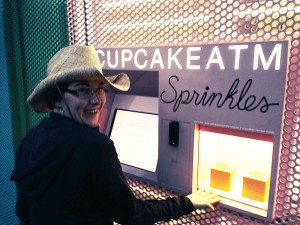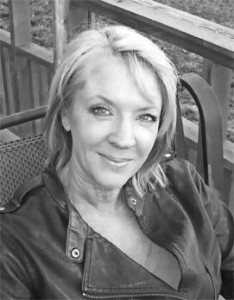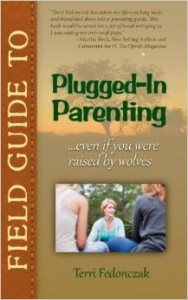
by Jenna | May 28, 2015 | Guest Posts
 Note from Jenna: This is a guest post by Naomi Dunford, my friend and business consultant who runs IttyBiz.com.
Note from Jenna: This is a guest post by Naomi Dunford, my friend and business consultant who runs IttyBiz.com.
Although she's writing from the perspective of business writing or blogging, her wonderful ideas for how to cope with "coming up empty" are useful for writers of all sorts.
Take a look and see what resonates as useful for you.

Today, I completely ran out of things to say.
I wrote the introductions for my next seven newsletters.
I found quotes for the next month.
I wrote 53 emails, planned a trip, and took two sales calls.
And I called my mother.
I should note here that I’m writing this on a Saturday.
I’m sure it comes as a surprise to nobody, but at some point in this process, I completely ran out of things to say.
And poor you! You are sitting there, breathlessly waiting for your next instalment of the IttyBiz daily and I am dry. I got nothing.
Hmm.
It’s weird when this happens. You’re on this crazy roll, getting an absolutely stupid amount of stuff done, and you’re getting accustomed to the momentum. It’s like shopping in a crazy busy mall. You get into a flow of bam! bam! bam! Dodge, charge, pivot, go, turn, and then…
Silence. Motionlessness.
It’s like all of a sudden the people are gone and the stores are shut and you’re not entirely sure what you’re supposed to do now.
What you are supposed to do now
When you are experiencing temporary burnout, you must do something that is not work.
That something should be, at minimum, comparable in time and attention level as a chunk of work. If you would be working for two hours, you should take at least two hours away. If you would be working on something mentally engrossing, you should do something equally engrossing.
This seems obvious to those around you, and yet completely counterintuitive to you. You think that you should stay busy, stay occupied, get something useful done. You think that you should try harder, or get a coffee, or stare at your computer screen for a while in case that solves the problem.
Nope. This is one of those few situations where the majority is actually right.
All your idiot friends who tell you that you need to take a little break, step away from the computer for a while? Those ones who just don’t get it?
Yeah, unfortunately, it’s you who doesn’t get it. (Please bear in mind here that when I say “you”, I mean “me”.)
Time for some practical examples!
If you were going to work on outlining your next project, and it was going to be mentally taxing, you need something that will not only utilize a completely separate area of your brain, but something that will actively restore you. A movie, perhaps. A run, maybe, as long as you’re not the type who thinks while you’re running.
If you were catching up on your emails and it wasn’t going to be taxing, you can just do something dumb and brainless. Candy Crush: Soda Saga is a nice choice here, but if you’re stuck on a level, you’ll only get five minutes. But the movie option still works. I routinely TiVo Jeopardy! for situations like this one.
If you’re doing something that’s making you numb, like taxes, you’re going to need something energizing. Some kind of personal treat would be a good idea, ideally something that gets you far away from the source of the problem. Drop in on a yoga class or get an ice cream. Bonus science points if you go somewhere you don’t normally go – it activates the novelty parts of your brain and makes you more alert for a good while afterwards.
Some tips for taking a break:
1. One thing that I find really helpful here is setting a little intention before you take your big break. I say something like, “OK, I’m going to go watch Legally Blonde so I can give my brain a chance to fully restore. That way I can come back rejuvenated and ready to kick some ass.”
I avoided doing this for a long time because I thought it was cheesy. Then I tried it and it worked. Then I tried it again and it worked again. Once the third time succeeded, I had to admit that it was a good strategy for me. I value science over ego, and if it works, it works.
2. If you hate the task, you may want to admit it to yourself. I don’t hate this task, I love it, but there are plenty I don’t love. When I was recording launch multipliers in month 11 of BIG LAUNCH, after I’d already done it once before but my computer wiped the files? Yeah, those are the kind of situations made for “Oh my God I ****ing hate my ****ing job and I ****ing hate this ****ing product and I swear I am moving to Costa Rica tomorrow.”
Sometimes, saying exactly how you feel is remarkably cathartic.
3. On the other hand, if it’s just standard issue fatigue, try to put a positive frame around your break. This is not the end of the world. You’re in a line of work that drains your resources. Being periodically drained is hardly a state of emergency. Sitting around saying you’re soooooo drained and soooooo tired and juuuuuust caaaaaaan’t work is not helpful.
Pretend you work for a moving company. Those guys are tired at the end of the day, and they probably can’t lift one more thing. You know what they do? They drink some beer, watch some baseball, and put their feet up. They do not put in an emergency call to their life coach, claiming existential catastrophe.
Sit down, enjoy your Strictly Ballroom, and smile. Your rejuvenating, not injured.
4. Plan for it. If you’re in a periodically draining line of work, this is going to happen. It might be a good idea to have a plan and some supplies on hand so you can immediately shift gears when you’re feeling the signs.
People with diabetes plan for crashes. Parents of preschoolers plan for crashes. Don’t get superstitious about this.
The more you plan for a crash, the faster you can recharge, and the faster you can get back on your feet.

Thanks for reading! Be sure to check out Naomi's other guest post here about writer's block.

by Jenna | Nov 19, 2014 | Guest Posts
 Note from Jenna: This is a guest post from my friend, writer, and favorite business consultant, Naomi Dunford.
Note from Jenna: This is a guest post from my friend, writer, and favorite business consultant, Naomi Dunford.
Naomi is an incredibly inspiring writer, and she also happens to be the only business consultant I ever recommend.
Her powerful piece had me in tears. I only wish I'd known what she was going through!
Write Like It Never Happened
by Naomi Dunford
So I had writers’ block for four years. That is not an exaggeration.
There was a week in the summer of 2010 when I had two life-changing conversations. In both of these conversations, each had with different people, and for different reasons, and ostensibly on different topics, the people I was speaking with suggested that perhaps lil ol’ me would be more successful and make more money and be more awesome if I acted, well, more like them.
They didn’t say it like that, of course. People don’t. When well-meaning people want to give advice, they tend to simply paint a picture, and it’s only if you look at that picture from a certain angle that you realize they have painted a picture of themselves.
Up until that time, I was following the very specific content marketing strategy of write when you are possessed of the urge to say something and publish it soon after. That resulted in between four and five blog posts a week most weeks, and sometimes there would be a week or so in which I had nothing to say, during which I didn’t write anything.
The people I spoke with thought that I should be more strategic.
They thought I should write blog posts that were designed to link to other blog posts, or to products, or services. They thought I should custom create blog posts purpose built to give opportunities for search engine traffic, “link bait”, and virality on social media.
This is good advice, actually. It’s certainly the advice I give when people ask me how to be more strategic with their content marketing. It’s the advice I give when people come to me asking for help. It’s the advice I give when people are starting from nothing and want to create something “the right way” from the start.
Like I said, it’s good advice. It just wasn’t great advice for me.
See, I wasn’t looking to get more strategic with my blog posts. I wasn’t looking to “optimize” or “take it to the next level” or “play a bigger game”. I had always found blogging to be one of the most rewarding activities I could possibly imagine. It was fun, and it made me smarter, and it helped me think, and it helped me grow.
Doing it my way got me into the Technorati Top 1000, meaning that, for a time, this was among the 1000 highest traffic blogs on the internet. (That honor, in tandem with two crisp American dollar bills, will get you a tall Pike Place blend at Starbucks, but still. It was good to know that I was good at something.)
What was it Toby Keith said? “A sucker punch came flying in from somewhere in the back”?
These conversations came out of the blue. They came from colleagues I admire. They came while we were supposed to be talking about something else, something nice. And the shock of them, the surprise of them, the “yes, that little blog you have is nice and all, but perhaps you should be a tad, I don’t know, manlier? ” condescension of them, well, I folded. I figured these guys must be right. Anything I had attained must have been in spite of myself, and if I wanted to go anywhere in life, I’d better start acting like a grown-up.
Unsurprisingly, when I went to the keyboard, I didn’t know what to write. When the only dictate is “whatever you do, don’t act like yourself”, it’s tough to figure it out. And I stayed that way for four years.
In the meantime, I have written. I’ve written for work – the classes and the emails and the sales copy. Over two million words, actually. But nearly none of them have been mine, and nearly all of them have been a struggle.
Sure, sometimes I would catch a groove and forget to obsess. Sometimes I would be on a deadline and didn’t have time to dwell. Sometimes I would drink wine and get angry and write what I damn well felt like, mentally hating the two of them the whole time.
But most of the time, what I had once loved, I’d grown to hate.
Which brings us to this summer.
This summer, I had two more conversations, one with a student, and one with a colleague.
The student emailed me to ask if she could write a certain kind of content in her newsletter. In her PS she said she hoped I’d say it was okay, because “that kind of thing would be a blast to write.” And I wrote back and said, “Go ahead. If it would be a blast to write, it will be a blast to read.”
(Hmmm. Physician, heal thyself?)
And then I talked to a colleague. I said I didn’t know what to put on my blog, and I hadn’t for years. We talked for a long time. He asked questions. I explained the problem. He thought for a while, and then he likened the whole thing to cupcakes.
 He said, “Remember that cupcake we got out of the ATM in Beverly Hills? Remember how it was perfect?”
He said, “Remember that cupcake we got out of the ATM in Beverly Hills? Remember how it was perfect?”
“Even if it wasn’t perfect, I still would have liked it. If it had been a little less moist, or it had been carrot cake instead of red velvet, or if it had less icing or, hell, no icing. When someone presents you with a cupcake, and it’s even a little bit good, your answer is not ‘Gee, I wish it was different.’ Your answer is ‘Sweet! A cupcake!’ You’ll even take a brownie, or a cookie, or a brownie with icing, or a cookie with brownie-flavored icing. You don’t care. You’re just happy you got a cupcake.”
“Maybe it’s the same with your blog. Maybe you don’t have to be a certain way. Maybe you can just make cupcakes.”
And so I tried. I tried to write even though I’d had writers’ block for four years. I tried to write myself up some cupcakes.
It was awkward. It was wooden. It was tentative and hesitant and SO not the same as it used to be. It felt like touching a lover after a four-year dry spell full of nasty silences and not very casual disregard. But I did it. And here we are.
Between four years ago and now, other well-meaning people have tried to give me advice on how to beat my writers’ block. It’s become a bit of a joke in the classes I teach. People come onto our Q&A calls and ask how my book is going, and we all laugh.
The advice people give about writers’ block can generally be paraphrased – or quoted verbatim – as “just write”.
I would ask what I should write, and they would say just write. I would ask how to start, and they would say just write. I would say I don’t know how, and they would say just write.
They were correct, of course. That’s exactly what I should have done. But their advice never held, it never stuck, because, well, I don’t know why. I wanted it to work. I just needed more, I guess.
You don’t understand, I would think. I can’t, because I’m stupid.
You don’t understand, I would think. I can’t, because I’m weird.
You don’t understand, I would think. I can’t because I’m loud and I’m brash and I swear too much. I can’t because those big, strong men I admire and respect told me I was doing it wrong.
And I suppose what I would have wanted was for somebody to take me by the shoulders and say this:
“Write like it never happened.”
“Don’t let them get you. Don’t let them break you. Don’t let them take the vitality and the fire and the sparkle that is you and sanitize it into a beiged-down version.
"Don’t change just because it makes other people feel safer. Don’t let them tell you that you would be perfect if you just weren’t so… you. Don’t let them take you away from everybody else who likes you just the way you are.
"I know it will be hard, and I know it won’t be the same, and I know you’ll doubt your every word for a while, but it will get better.
"Do you remember when you were little, and you swore you would never let anyone break you down, no matter how hard they tried? That small person inside of you is counting on you to make all her dreams come true. That small person said that one day, she would write and people would read, and that mess of a childhood would be transformed into something better. Nobody can make it okay for that small person but you.
"Write like it was ten years ago and nobody had told you that you couldn’t do it. Write like it was possible. Write like you had hope, and write like you had dreams, and write like there are millions of people out there waiting to hear what only you can say.
"Write like you did before it ever occurred to you that there might be anyone who wanted you to be different.
"Outrun it. Outrun the feeling that they might be right. Outrun it, outwrite it, and drown it with voices of love and support and admiration and high fives.
"Listen to your children who believe you can do everything and that Mummy is the wisest, strongest, prettiest person in the whole world. Put your trust in the ones who know you and love you and never want you to change. Write and write and write and write and write, no matter what, write.
"It. Will. Get. Better.”
I think that’s what I would have wanted to hear.
So just in case that’s what you want to hear, and you need somebody to say that to you, I’ll say it to you now:
Write like it never happened.

Naomi Dunford's first piece of published writing was a review of Coneheads for the local paper. She was 12. Her greatest writing related achievement is getting 104% on an essay about "The Fatal Flaw In King Lear", a play which she has heard is very moving. She writes Morning Pages about once a year.
She is a business consultant, writer, and blogger who started her company, IttyBiz, in 2006 and has been featured in numerous books you probably own but have not read.


by Jenna | Nov 13, 2014 | Guest Posts
 Note from Jenna: This guest post from one of my favorite writers and colleagues: Jamie Lee Scott.
Note from Jenna: This guest post from one of my favorite writers and colleagues: Jamie Lee Scott.
Jamie is an amazing author, screenwriter, and entrepreneur who has a real handle on the world of independent publishing. I asked her to share her insights about the differences and advantages of self-publishing versus traditional publishing, since I know many of us are considering the indie publishing route.
Enjoy it — I know I learned a ton just from reading her piece.

The (not so) New World of Indie Publishing
by Jamie Lee Scott
It wasn’t long ago that self-publishing was deemed “vanity” publishing and was frowned upon by the traditional establishment.
Fast forward to 2011, and a new landscape.
Vanity is a word no longer in the vocabulary, and writers no longer need the traditional gatekeepers (agents, editors, publishers) to tell them what will sell and what won’t, what’s hot and what’s not. Writers can now write what they love and get it in front of readers in record time. Traditional publishers may take as long as two years to get a book from contract to readers, where an independently published author can do the same in a matter of weeks or months.
My choice to go indie
My decision to publish independently was easy.
I had Let Us Prey finished and I’d been sending out query letters for months. It had been getting some interest when my friend, New York Times bestselling author Jennie Bentley, asked me if I was interested in self-publishing. At the time I wasn’t even sure what self-publishing was, so I did my research. Jennie explained that if I took a contract with a small publisher, with a tiny advance, I’d be lucky to see my book in print by 2013, and even luckier to earn out my advance.
My chances of earning money from my book, and making enough to want to write another would be better if I jumped the traditional ship and waded into the indie publishing waters. Jennie, who herself was wading in those waters with a series of her own, threw me a life vest, and together we swam like our lives depended on it.
If I’d gone the traditional route, I’d be languishing with the mid-list authors, making a few thousand dollars a year if I was lucky, instead I’ve published five novels, one novella, and closed my manufacturing business to concentrate exclusively on my writing.
And I’m not alone.
Two extremely successful, and very generous writers, Liliana Hart and Jana DeLeon, were pioneers in indie publishing, have paved the way for many of us and are part of a collaborative effort to help others in a book called The Naked Truth about Self-Publishing. They’ve been the faces and voices for the masses along with many others who have paid it forward. There are too many to name here, but rest assured you will find them at conferences and talking to authors, generous with their information.
The writer is responsible for all aspects of the publishing process
The biggest difference between traditional and indie publishing is that the writer is responsible for all aspects of the publishing process.
So, if done well, the process is going to cost some money. How much depends on how professional you want your books to look.
Don’t skimp on editors, or cover design. Don’t judge a book by its cover doesn’t apply here, because the cover is the first glimpse and may sometimes be the only thing that makes the reader want to look further. If your cover looks as professional as the New York Times bestseller covers, you have a better chance the browser will look at the book description than if the book has an amateurish cover. Giving the book a fighting chance at the start is a must.
And then don’t turn them off by not having the book professionally edited. This book is going to sell your next book. If it isn’t well-written, and edited, you aren’t going to sell the next one, so why bother?
Spend the money now, and you’ll reap the rewards in the long run.
Whether you are traditionally published or indie, you are your marketing director.
Unless you signed a multi-million dollar traditional contract, no one is going to be running a PR campaign for you. The writing is the easy part.
So, now that the first book is written, great, now get your butt back in the seat and start writing the next one. In between, become a marketing guru, and help others along the way if you can.
Podcast in the making
I’ve been so lucky to have help from so many along the way, including the authors of Mirth, Murder and Mystery, that I decided to start a podcast to help others who are interested in becoming authors, either traditionally published or indie published. The podcast is called Indie Girl’s Guide to Self-Publishing and launches this December. It’s a weekly podcast for authors to help navigate the ins and outs of the crazy but interesting and possibly lucrative world of indie publishing.
This is not a get rich quick scheme
Lest you mistakenly think this is a get rich quick scheme, let me assure you, it’s long hours, hard work, and lots of blood, sweat and tears. The market (and algorithms) change on a dime, and keeping up is part of the game. Not only do indie authors have to keep writing, they have to keep in touch with the markets, changes, and much, much more.
Is it worth it?
I think so.

Jamie Lee Scott is the USA Today bestselling author of the Gotcha Detective Agency Mystery Series, and the founder of Indie Girl Self-Publishing Podcast.
She’s the co-founder of Script Chat #scriptchat and TV Writer Chat #tvwriterchat on Twitter, and writer of the award winning short film No One Knows.
You can find Jamie online on Facebook, Twitter, and at her websites, www.jamieleescott.com and www.indiegirlselfpub.com.
 Thanks for reading!
Thanks for reading!
Note: Amazon links in this post are affiliate links and may generate a small amount of referral income for this blog.

by Jenna | Aug 13, 2014 | Guest Posts
 Note from Jenna: This guest post from one of the fabulous writers in my community members: Sonya Sigler. In this article Sonya talks how she’s set herself up for ongoing success with her writing, despite her “love-hate” relationship with it (which so many of us have!).
Note from Jenna: This guest post from one of the fabulous writers in my community members: Sonya Sigler. In this article Sonya talks how she’s set herself up for ongoing success with her writing, despite her “love-hate” relationship with it (which so many of us have!).
Enjoy.
My Love-Hate Relationship with Writing
Putting good habits in place to find more of the love
by Sonya Sigler
I love, love, love the finished product from writing. I love hitting the publish button once I’ve written a blog post. I love submitting an article and hitting the send button before the deadline. I love seeing my work in print. I love to journal, for me and each of my kids (how else would I remember what they do on a daily basis?). Most of all, I love sharing knowledge and ideas with others through the written medium.
The big “but”
But, and this is a big but, I hate sitting down to write. Once I sit down to write, I apparently must send a big sign out to the universe to let the hemming and hawing begin, because once I sit down, the negative chorus in my head starts in, saying, “Why did you agree to do this?”
If I am at home, instead of writing, I’ll do the dishes and clean the kitchen. Or start a load of laundry. Or sweep and vacuum. If I’m at work, I clean my office, file things, or make phone calls. I check my email, I go on Facebook or LinkedIn to see what others are up to. I make a cup of tea, I look for food to eat (carbs, mostly, of course). I do ANYTHING but sit down and write!
In short, instead of sitting down to write, I procrastinate.
Why? Why do I procrastinate?
I procrastinate because I am letting perfect be the enemy of the good. I procrastinate because I want the entire article to be written in my head before I start. I procrastinate because I want my writing to convey the awesome ideas I have in my head – just as they appear in my head – elegant and articulate.
I procrastinate because I want my writing to be perfect.
Writing is a habit
What I’ve learned in the writing community is that writing is a habit, and putting a good habit in place is the key to my writing success.
I’ve also learned that the writing habit is a constant and consistent process. I write a little every day. I have tons of ideas, so that isn’t the issue. For me, the issue is writing every day, consistently, for any amount of time. I now aim to write for five minutes a day.
I can hear you thinking now: “Five minutes, is that all?”
Yep, for me, that is the threshold of a set goal I can absolutely meet.
It’s also the amount time that motivates me to sit down and write. A target of 15 minutes of writing time was too high; I would blow it off, even though it was on my calendar. I would ignore it. I would say to myself, “Oh, you can write later this afternoon when you have more time.”
Really?
No.
That wasn’t working for me.
To achieve the success with my writing I wanted, I had to set a small goal that I could consistently meet, every day. For me, five minutes was it. Five minutes was a writing routine that I could do consistently, no matter what.
Other tricks for writing success
In order to make it as easy as possible to meet my five minute daily goal, I use other tricks to make writing happen, like:
- Bringing my writing with me. I take a journal with me when I pick up the kids and find that I have to wait.
- Sitting down first thing in the morning after exercising to write for five minutes. I jot down ideas. I write one word, one sentence, or one paragraph at a time.
- Keeping drafts in Evernote I can access from any device. I bring my iPad or iPad Mini with me so that I can write when I have five minutes.
Letting go of preconceived notions
I also found that for this new habit to sink in and stick that I had to let go of a few preconceived notions about writing, like the idea of perfect writing conditions. I had in my mind the perfect writing condition being a long stretch of time (read, at least 8 hours), that is quiet with no distractions or interruptions.
Yeah, right. When has that ever happened?
Never.
I also had to let go of the notion of “proper” writing. I’m an attorney. I do a lot of legal writing, a lot of writing for lawyers. I’ve had to let go of the idea that I am writing a formal or “proper” law review-like article with extensive footnotes and case citations. To let go of the notion of proper writing I’ve learned to keep my audience in mind so I can write in the voice for that particular audience, whether it is lawyers, technologists, moms, or entrepreneurs.
Lessening perfection to find the love
Changing my writing habit required a mind-shift – letting go of the notion that perfect writing conditions exist and letting go of the notion of always having to do “proper” writing. Changing my writing habit also required me to put a few things in place to make writing easy to say “Yes” to each day.
Now, I believe I can write whether I sit down for five minutes at a time or for an hour, and whether I sit down to write one word at a time or one sentence at a time. Sometimes the words all flow out at once, sometimes the writing is painstakingly done one word at a time.
In any case, eventually, it gets done. This awareness and shift in thinking helped lessen the grip of “perfection” on me and allows me to spend more time on the “love” side of writing!

Sonya Sigler is an executive coach, consulting in operations, legal, and business development with start-ups and other high-growth companies. She is a staunch advocate for women in technology and is focused on sharing practical advice. You can find her online at http://www.sonyasigler.com, view her LinkedIn profile, or follow her on Twitter @sonyasigler

by Jenna | Aug 7, 2014 | Guest Posts
 Note from Jenna: This guest post is from Terri Fedonczak, a parenting coach, author, and writing community coach.
Note from Jenna: This guest post is from Terri Fedonczak, a parenting coach, author, and writing community coach.
I’ve loved working with Terri through the writing community over the last few years, first as a participant, then as a coach. She knocked our socks off by finishing the first draft of her parenting book in just three 28-day sessions of the writing community in 15 minute increments of time – after having had the book “brewing” in her for over 15 years. Amazing!
Just Show Up
by Terri Fedonczak
When I joined the writing community in 2012, I knew that I wanted to finally get my book out of my head and into my computer. I had been “writing” this parenting book for 15 years, as I knew that I needed to get one kid through adolescence before I could have any street cred with other parents. I put writing in quotations, because the book was mostly on tape. The little bit of writing that I did have was on sticky notes and spread across a dozen journals.
In my first session with the community, I thought I would just get organized. My goals were very small: only 15 minutes a day 6 to 7 days a week. Much to my surprise, I finished the rough draft in just three sessions. “Rough” is an understatement as a descriptor for that first draft. It was a 30-page booklet of disjointed ideas. I told myself that I wanted to keep it short, because parents were too busy to read a long book. That was a nice justification for keeping the real story to myself.
When I sent my booklet to my chosen editor, she immediately outed me. She said, “I will edit this book the way it is, but it wants to be so much more. There’s no heart and soul in it. YOU aren’t in your book. There’s nothing about your breast cancer, no struggle, no life coaching journey . . . there’s no mess here. Parenting is messy. You need to show other parents your mess.” She was right. And that started an 18 month journey of re-writes and edits.
Let Go of Expectations
One thing I’ve learned in the writing community is that writing is both infinitely easier and more challenging than I ever expected. It’s more helpful if you flush your expectations of how long it will take or who will like it and just keep showing up to the page every day.
As a coach, I see brilliant writers spending lots of time and energy worrying about what other people will think of their writing, or fretting about how long it will take (or is taking). All this worry keeps us in ours heads. Good writing doesn’t come from the head – it comes from the heart. Meaningful writing grabs the reader with its simplicity and elegance and just won’t let go.
As readers, we don’t care about how long the writing took or how smart the author is, we want to care about what we’re reading. You can’t fake that or wordsmith your way around it. All you can do is show up to the page and show us your mess.
From Dream to Reality
 My book went from a dream to a reality. It’s now on Amazon* online, and it was endorsed by the Washington Post as a “must read” in their February Parenting Book Round Up.
My book went from a dream to a reality. It’s now on Amazon* online, and it was endorsed by the Washington Post as a “must read” in their February Parenting Book Round Up.
But more importantly, I have parents tell me how much the book has changed their parenting for the better. That makes it all worthwhile.
This Is What Success Looks Like
So, 15 years of vomiting ideas onto paper or tape, one month to a rough draft, and 18 months to re-write and publish. This is what success looks like; it’s not quick and it’s not easy. But with the support of other writers, a dogged determination to show up to the page every day, even just for 5 minutes, and the courage to show us your mess, you will arrive at your own version of success.

 Terri Fedonczak wants to live in a world where girls recognize their own power and choose to use it for good. On a trip to South Africa, Terri saw the power of the lioness and how they support their pride; it was a lightning bolt of realization that her mission is to bring the power of the pride to girls and their parents. Terri was a commercial real estate agent for 16 years until a bout with breast cancer transformed her life in 2010. She realized that trading money and status for time with her four girls and patient husband was not quite the deal she thought it once was. She left sales to become a certified life coach and embark upon a journey of spreading the message of girl power far and wide.
Terri Fedonczak wants to live in a world where girls recognize their own power and choose to use it for good. On a trip to South Africa, Terri saw the power of the lioness and how they support their pride; it was a lightning bolt of realization that her mission is to bring the power of the pride to girls and their parents. Terri was a commercial real estate agent for 16 years until a bout with breast cancer transformed her life in 2010. She realized that trading money and status for time with her four girls and patient husband was not quite the deal she thought it once was. She left sales to become a certified life coach and embark upon a journey of spreading the message of girl power far and wide.
Terri is a featured speaker at the Costa Leadership Institute, helping adults balance their lives, and she takes the girl power message into high schools, talking to 9th grade girls about how to thrive in high school. Her first book, Field Guide to Plugged-in Parenting, Even If You Were Raised by Wolves, debuted in 2013. When she’s not speaking, coaching or blogging, you can find her paddle boarding on the sparkling waters of Boggy Bayou, knitting to the consternation of her children, who are buried in scarves and hats, or dancing in her kitchen to Motown.
You can discover your own inner lioness and feel the power of the pride at www.girlpowerforgood.com.
* Affiliate link

by Jenna | Jul 23, 2014 | Guest Posts
 Note from Jenna: This guest post is from one of our excellent writing community coaches and screenwriter, Sarah Newman. I’ve been thrilled to have Sarah as a coach over the last year and a half, and her group participants absolutely adore her (as do I). She brings a compassionate, listening spirit to her coaching and she is an excellent role model with her strong writing work ethic. In her own writing, Sarah primarily works on TV pilots and features.
Note from Jenna: This guest post is from one of our excellent writing community coaches and screenwriter, Sarah Newman. I’ve been thrilled to have Sarah as a coach over the last year and a half, and her group participants absolutely adore her (as do I). She brings a compassionate, listening spirit to her coaching and she is an excellent role model with her strong writing work ethic. In her own writing, Sarah primarily works on TV pilots and features.
Today Sarah has written about several clever ways she and her group members have discovered to get themselves unstuck, past any fear or uncertainty, and stay in action with their writing.
Take a look and see what might work for you!
7 ways to overcome fear and uncertainty about writing
by Sarah Newman
One of my favorite aspects of working as a coach with the writing community is how my group participants and I learn so much from each other by sharing our writing processes and challenges in our online progress logs on the writing community site.
Through this work together, we’ve learned a great deal from each other about how to get going with our writing in spite of any fear, doubt, or uncertainty we’re facing.
Here are seven of my top methods to keep the writing moving that we’ve embraced in my group:
1. Work outside the document
One of our favorite ways to overcome fear or uncertainty with a section of writing is by working on it “outside” of the main document.
When I use this technique, it might look like opening a new blank document (sometimes I label mine “scrap” to really take the pressure off) or putting pen to paper. I find this gives me a greater sense of freedom to try something out and to write more boldly.
When working on rewrites, I’ll sometimes take a scene I’ve written and paste it into a new blank document to experiment with combining it with another scene or to make changes and cuts. It feels less set in stone and safer, knowing the original version is there if I want to revert back to it.
One of my group participants put her own twist on this by doing what has come to be known in our group as a “literal cut and paste”, where she’ll print and cut out sections of her chapter and move them around to assess the flow and to determine where cuts or additions can be made.
2. Have a conversation with yourself on the page
Some of my participants and I find ourselves ruminating on our projects in our morning pages or keeping a project journal to record thoughts and reflections. Having a safe place to explore our writing can lead to important insights and breakthroughs.
We journal in response to questions about content, like:
- What’s the worst thing that could happen to my protagonist at this point?
- What would be the most interesting location for this scene?
Or we dialogue with ourselves about issues coming up for us around the writing itself, by answering questions like:
- Why am I shying away from digging deeper here?
- What initially drew me to this project?
- What do I need in order to keep going?
It’s about having a conversation with yourself and writing out all possible answers, no matter how silly some may seem. We find that this process helps us get past our inner critic’s judgments and back into the flow of writing.
3. Remind yourself that no writing is wasted
We have a “no writing is wasted” motto in my group.
Whether we end up changing the material or cutting it completely, it still has value in moving us forward . . . even if it feels like it moved us backwards or sideways!
Trying something, anything, is often better than trying nothing at all and can get us going again with our writing. Mistakes are valuable. Those “wrong” turns often lead us to the “right” path.
4. Sit with the mystery
It may be uncomfortable at first as the cursor blinks tauntingly, but the process of writing itself often generates connections and ideas that will help us find our way. We don’t have to have all the answers up front.
I love when my group participants report that by sticking with it and giving themselves permission to just write, they were able to have a breakthrough.
Reframe your self-doubt and uncertainty as a call to adventure with possibilities to explore.
5. Walk it out
And then again, sometimes it can be helpful to know when to get up and take a break.
Going for a walk is a common practice in my group. My participants often report finding inspiration out in nature.
For myself, I find many ideas are born and problems solved while I wander the streets of New York City. Not to mention the added bonus of overhearing potential tidbits of dialogue. :)
6. Make friends with a timer
Solo writing sprints are part of many of our writing routines, in addition to the daily scheduled group sprints through the writing community. With the help of our trusty timers we fight the good fight against procrastination and resistance. On days when it’s difficult to start, perhaps we’re distracted or perhaps we’re facing a particularly challenging piece of the writing, we’re able to coax ourselves to get going by setting that timer for a small, doable amount of time.
I find I’ve become trained so well now that once I hit that start button, I’m off and writing, and I often find myself resetting it for more time.
7. Trust the process
Recently I noted how it helps to trust the process even when I can’t necessarily see it at work. This is true for my group participants as well. If we continue to show up and chip away, the writing naturally unfolds. As much as we sometimes want to get more done and hurry up to finish, patience with ourselves and trusting the process helps us remain consistent and see things through to completion, even when fear or doubt wants to lead us astray.

Sarah Newman is a published writer living in New York. She writes short fiction & creative non-fiction, original one-hour drama pilots & screenplays, and zines. Sarah studied dramatic writing at NYU’s Tisch School of the Arts. When she’s not writing, reading, or watching story in all its glorious forms, you can find her on walking adventures around New York City and on Twitter at @mischiefandmusings.bsky.social.

Thanks for reading!
We’d love to hear your thoughts in the comments.
Warmly,

 He said, “Remember that cupcake we got out of the ATM in Beverly Hills? Remember how it was perfect?”
He said, “Remember that cupcake we got out of the ATM in Beverly Hills? Remember how it was perfect?”![]()
![]()


 Note from Jenna: This is a guest post by Naomi Dunford, my friend and business consultant who runs IttyBiz.com.
Note from Jenna: This is a guest post by Naomi Dunford, my friend and business consultant who runs IttyBiz.com.

 Note from Jenna: This guest post from one of my favorite writers and colleagues: Jamie Lee Scott.
Note from Jenna: This guest post from one of my favorite writers and colleagues: Jamie Lee Scott. 

 Note from Jenna: This guest post from one of the fabulous writers in my community members: Sonya Sigler. In this article Sonya talks how she’s set herself up for ongoing success with her writing, despite her “love-hate” relationship with it (which so many of us have!).
Note from Jenna: This guest post from one of the fabulous writers in my community members: Sonya Sigler. In this article Sonya talks how she’s set herself up for ongoing success with her writing, despite her “love-hate” relationship with it (which so many of us have!).

 My book went from a dream to a reality. It’s now on
My book went from a dream to a reality. It’s now on  Terri Fedonczak wants to live in a world where girls recognize their own power and choose to use it for good. On a trip to South Africa, Terri saw the power of the lioness and how they support their pride; it was a lightning bolt of realization that her mission is to bring the power of the pride to girls and their parents. Terri was a commercial real estate agent for 16 years until a bout with breast cancer transformed her life in 2010. She realized that trading money and status for time with her four girls and patient husband was not quite the deal she thought it once was. She left sales to become a certified life coach and embark upon a journey of spreading the message of girl power far and wide.
Terri Fedonczak wants to live in a world where girls recognize their own power and choose to use it for good. On a trip to South Africa, Terri saw the power of the lioness and how they support their pride; it was a lightning bolt of realization that her mission is to bring the power of the pride to girls and their parents. Terri was a commercial real estate agent for 16 years until a bout with breast cancer transformed her life in 2010. She realized that trading money and status for time with her four girls and patient husband was not quite the deal she thought it once was. She left sales to become a certified life coach and embark upon a journey of spreading the message of girl power far and wide.
 Note from Jenna: This guest post is from one of our excellent writing community coaches and screenwriter, Sarah Newman. I’ve been thrilled to have Sarah as a coach over the last year and a half, and her group participants absolutely adore her (as do I). She brings a compassionate, listening spirit to her coaching and she is an excellent role model with her strong writing work ethic. In her own writing, Sarah primarily works on TV pilots and features.
Note from Jenna: This guest post is from one of our excellent writing community coaches and screenwriter, Sarah Newman. I’ve been thrilled to have Sarah as a coach over the last year and a half, and her group participants absolutely adore her (as do I). She brings a compassionate, listening spirit to her coaching and she is an excellent role model with her strong writing work ethic. In her own writing, Sarah primarily works on TV pilots and features.